
| Rafter Diamond K Livestock Located south of Sherwood Park, Alberta which is near Edmonton, Alberta |
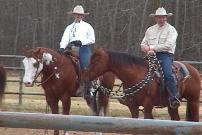
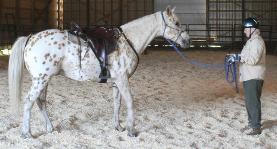

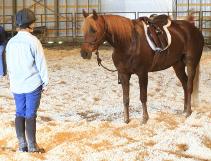

| What is the lead rope connected to? Her feet - even though tied to her head, if not connected to her feet she will be where she wants to be and not necessarily where you want to go |
| Why should you teach your horse to stand? For safety & to build trust Are they paying attention to you? If their mind is not on you, then they are distracted and wrecks can happen when you surprise them with your request to do something. |
| Why would you ever want to teach this? If your horse is relaxed you will both have a better ride. No you don't have to do it every time. It is just fun to see if you can |












When horses lick
their lips or
mouths when
you are working
with them it is a
good thing
If you don't
know why, then
maybe you
should come
visit us.
their lips or
mouths when
you are working
with them it is a
good thing
If you don't
know why, then
maybe you
should come
visit us.




Why is groundwork so
important?
It connects the
reins to the feet
and leads to
success in the
saddle. If your
horse respects
you on the
ground she is
more likely to
respect you on
her back too.
important?
It connects the
reins to the feet
and leads to
success in the
saddle. If your
horse respects
you on the
ground she is
more likely to
respect you on
her back too.

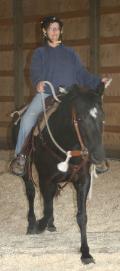




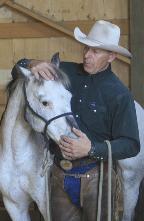

| Why do we do this? For the smiles on the riders and the softness in their horses. Thanks everyone for your willingness to hear and try. |
How can I use a
horse's natural
curiousity to help me?
Dragging a scary object
away from a horse will
often cause them to
want to find out what it
is.
horse's natural
curiousity to help me?
Dragging a scary object
away from a horse will
often cause them to
want to find out what it
is.
The weekend wasn't perfect but great lessons were learned in these
difficulties -
The little grey mare to the left had not been used by her owners for many
years but circumstances brought her into use for the weekend. She was
extremely ear shy and would not accept the bridle. Through the weekend
she got better and her owners left with some ideas about how to continue
to help her. Stormy, Ken's 4 yr old gelding, got some practice in helping
Ken make a difference in the life of a troubled horse.
The paint gelding below has been to several clinics for help with his right
lead. Unfortunately he came up lame on the second day so they will need to
continue to practice balance, straightness, bending, feel, timing and balance
at home. Having his specific problem allowed for some good discussion on
getting a horse ready to take the correct lead.
When your horse is having difficulty it is the owners' responsibility to learn
how a horse takes the correct lead and then as Ray Hunt says, "prepare the
horse to the position for the transition."
"In order for it to be understood it has to be effective and in order to be
effective it has to be presented to the horse in a way the horse can
understand." (Ray Hunt)
difficulties -
The little grey mare to the left had not been used by her owners for many
years but circumstances brought her into use for the weekend. She was
extremely ear shy and would not accept the bridle. Through the weekend
she got better and her owners left with some ideas about how to continue
to help her. Stormy, Ken's 4 yr old gelding, got some practice in helping
Ken make a difference in the life of a troubled horse.
The paint gelding below has been to several clinics for help with his right
lead. Unfortunately he came up lame on the second day so they will need to
continue to practice balance, straightness, bending, feel, timing and balance
at home. Having his specific problem allowed for some good discussion on
getting a horse ready to take the correct lead.
When your horse is having difficulty it is the owners' responsibility to learn
how a horse takes the correct lead and then as Ray Hunt says, "prepare the
horse to the position for the transition."
"In order for it to be understood it has to be effective and in order to be
effective it has to be presented to the horse in a way the horse can
understand." (Ray Hunt)

Where should
my hands be
when I am
riding?
Your hands
should be
wherever they
need to be to
support and guide
your horse. If
she is not sure
about something,
then open your
hands and use
gentle bumps to
keep her straight.
my hands be
when I am
riding?
Your hands
should be
wherever they
need to be to
support and guide
your horse. If
she is not sure
about something,
then open your
hands and use
gentle bumps to
keep her straight.
Many, many thanks to
Johane Janelle who
took pictures for the
not well lit for picture
taking, but I'm sure
you will agree she did
an awesome job.
If you are interested in
having Johane take pics
for you, you can
contact her at
www.johanejanelle.com
Johane Janelle who
took pictures for the
not well lit for picture
taking, but I'm sure
you will agree she did
an awesome job.
If you are interested in
having Johane take pics
for you, you can
contact her at
www.johanejanelle.com
What are some things dragging teaches?
A horse cannot see directly behind them,
so they must learn to trust that their rider
will keep them from being harmed by the
"creature" behind them.
A horse cannot see directly behind them,
so they must learn to trust that their rider
will keep them from being harmed by the
"creature" behind them.
Dragging in "wiggly lines" also
teaches a horse to change
eyes. Did you wonder why
the people were walking
around the back of their
horses in the pics above?
Learning to change eyes is
best accomplished from the
ground first.
teaches a horse to change
eyes. Did you wonder why
the people were walking
around the back of their
horses in the pics above?
Learning to change eyes is
best accomplished from the
ground first.
And why is learning to change
eyes important?
Because a horse has a split brain.
What one eye sees is not
communicated to the other half of
disappears behind the horse and
reappears on the other side it is a
"brand new object" to be assessed
for danger.
Exercising both sides of the brain
builds balance which develops
confidence in the horse. The horse
is learning confidence from you and
therefore begins to respect your
leadership.
eyes important?
Because a horse has a split brain.
What one eye sees is not
communicated to the other half of
disappears behind the horse and
reappears on the other side it is a
"brand new object" to be assessed
for danger.
Exercising both sides of the brain
builds balance which develops
confidence in the horse. The horse
is learning confidence from you and
therefore begins to respect your
leadership.
| It is also important to your horse that you are confident she can make it. Look up and think beyond your obstacle. |
Why does my horse go sideways
when I am standing on the
mounting block?
Because horses prefer to look
straight at something they don't
quite understand, they turn so they
can see you squarely with both
eyes and therefore with both sides
of their brain.
when I am standing on the
mounting block?
Because horses prefer to look
straight at something they don't
quite understand, they turn so they
can see you squarely with both
eyes and therefore with both sides
of their brain.
Take the time to teach your horse to "pick you up" off the fence, a
mounting block/box, a trailer, a rock - even if you don't need one.
They will learn a valuable skill in standing still while being mounted and
in trusting you when you ask them to do something. You too will gain
some valuable lessons in connecting those reins to those feet so those
feet put his body where you need it.
mounting block/box, a trailer, a rock - even if you don't need one.
They will learn a valuable skill in standing still while being mounted and
in trusting you when you ask them to do something. You too will gain
some valuable lessons in connecting those reins to those feet so those
feet put his body where you need it.
Aren't cavaletti's for jumping?
Sure, but if you are out for a
relaxing trail ride do you really
want your horse jumping every
low obstacle or puddle?
Your horse should be able to
jump low obstacles when you
ask or walk them if that is what
you want to do.
Asking your horse to stop part
way over obstacles builds feel
and timing in both of you.
Sure, but if you are out for a
relaxing trail ride do you really
want your horse jumping every
low obstacle or puddle?
Your horse should be able to
jump low obstacles when you
ask or walk them if that is what
you want to do.
Asking your horse to stop part
way over obstacles builds feel
and timing in both of you.
In every horse discipline except cutting, your
horse should wait for you to tell him what to
do and then do what you ask without
resentment.
Developing feel, timing and balance in both
of you can be done in many ways, and the
more different things you try, the less bored
you will both be.
This is a low teeter-totter, so when the horse
steps on one end, the other end moves. For
this reason, sometimes it is best to start by
walking straight across the middle to gain
confidence.
horse should wait for you to tell him what to
do and then do what you ask without
resentment.
Developing feel, timing and balance in both
of you can be done in many ways, and the
more different things you try, the less bored
you will both be.
This is a low teeter-totter, so when the horse
steps on one end, the other end moves. For
this reason, sometimes it is best to start by
walking straight across the middle to gain
confidence.
Why does my horse dig holes when tied?
Usually because they learned that if they dig a hole you will come and pay
attention to them - or even better, turn them loose.
Retraining is hard, starting right is better. After a good ride, they are more
likely to be willing to stand for a short while. Turn them out before they
get anxious or bored and their patience will grow.
Oh yes, and some "green snake training" (garden hose) or some other
activity of interest going on around them at the same time might just keep
their attention longer if it won't cause a wreck. Use your good judgement.
Usually because they learned that if they dig a hole you will come and pay
attention to them - or even better, turn them loose.
Retraining is hard, starting right is better. After a good ride, they are more
likely to be willing to stand for a short while. Turn them out before they
get anxious or bored and their patience will grow.
Oh yes, and some "green snake training" (garden hose) or some other
activity of interest going on around them at the same time might just keep
their attention longer if it won't cause a wreck. Use your good judgement.
How do I get my horse to approach
something he is afraid of?
Work him softly back and forth without
letting him turn away from it. Focus on
bending and changing eyes, at the edge of
his comfort zone. As he gains experience
and feels your confidence without beating
on him, his comfort zone will shrink and the
next thing you know you will be playing
soccer with your friends.
If you get even the slightest change, reward
him by taking the pressure off. Go do
something different for a moment or two
and then come back to it again.
something he is afraid of?
Work him softly back and forth without
letting him turn away from it. Focus on
bending and changing eyes, at the edge of
his comfort zone. As he gains experience
and feels your confidence without beating
on him, his comfort zone will shrink and the
next thing you know you will be playing
soccer with your friends.
If you get even the slightest change, reward
him by taking the pressure off. Go do
something different for a moment or two
and then come back to it again.
Ken and Kerri-Lee Schmuland
50542 Range Road 225
Leduc County AB T0B 3M1
Web presence:
www.rafterdiamondk.com
horses@rafterdiamondk.com
Facebook group - Rafter Diamond K
Livestock
Telephone contact:
Home: 780-449-0749
Fax: 780-449-0761
Ken cell: 780-915-3026
Kerri-Lee cell: 780-915-3027
Tamara cell: 780-221-3028
We are in Leduc County, Alberta,
Canada
20 minutes southeast of Edmonton,
Alberta
15 minutes south of Sherwood Park,
Alberta
12 minutes east of Beaumont, Alberta
30 minutes northeast of Leduc,
Alberta
5 minutes west of Northern Bear Golf
Course
We are two miles east of Highway 21
between Township road 510 to the
north and Secondary 625 to the south.
50542 Range Road 225
Leduc County AB T0B 3M1
Web presence:
www.rafterdiamondk.com
horses@rafterdiamondk.com
Facebook group - Rafter Diamond K
Livestock
Telephone contact:
Home: 780-449-0749
Fax: 780-449-0761
Ken cell: 780-915-3026
Kerri-Lee cell: 780-915-3027
Tamara cell: 780-221-3028
We are in Leduc County, Alberta,
Canada
20 minutes southeast of Edmonton,
Alberta
15 minutes south of Sherwood Park,
Alberta
12 minutes east of Beaumont, Alberta
30 minutes northeast of Leduc,
Alberta
5 minutes west of Northern Bear Golf
Course
We are two miles east of Highway 21
between Township road 510 to the
north and Secondary 625 to the south.